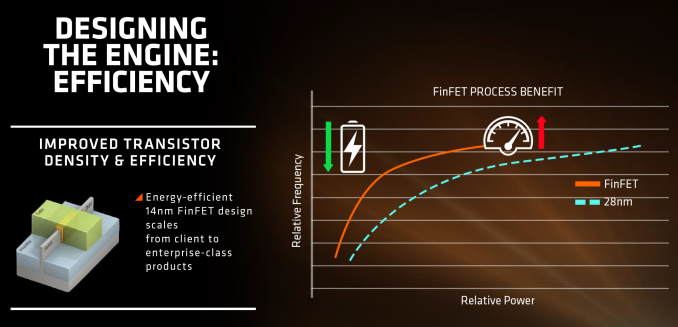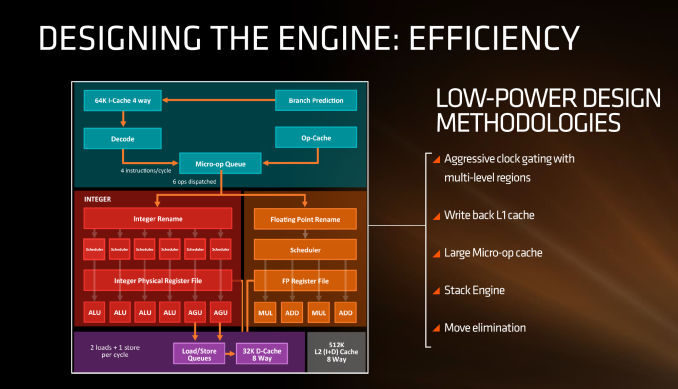AMD Zen Microarchitecture: Dual Schedulers, Micro-Op Cache and Memory Hierarchy Revealed
by Ian Cutress on August 18, 2016 9:00 AM ESTLow Power, FinFET and Clock Gating
When AMD launched Carrizo and Bristol Ridge for notebooks, one of the big stories was how AMD had implemented a number of techniques to improve power consumption and subsequently increase efficiency. A number of those lessons have come through with Zen, as well as a few new aspects in play due to the lithography.
First up is the FinFET effect. Regular readers of AnandTech and those that follow the industry will already be bored to death with FinFET, but the design allows for a lower power version of a transistor at a given frequency. Now of course everyone using FinFET can have a different implementation which gives specific power/performance characteristics, but Zen on the 14nm FinFET process at Global Foundries is already a known quantity with AMD’s Polaris GPUs which are built similarly. The combination of FinFET with the fact that AMD confirmed that they will be using the density-optimised version of 14nm FinFET (which will allow for smaller die sizes and more reasonable efficiency points) also contributes to a shift of either higher performance at the same power or the same performance at lower power.
AMD stated in the brief that power consumption and efficiency was constantly drilled into the engineers, and as explained in previous briefings, there ends up being a tradeoff between performance and efficiency about what can be done for a number of elements of the core (e.g. 1% performance might cost 2% efficiency). For Zen, the micro-op cache will save power by not having to go further out to get instruction data, improved prefetch and a couple of other features such as move elimination will also reduce the work, but AMD also states that cores will be aggressively clock gated to improve efficiency.
We saw with AMD’s 7th Gen APUs that power gating was also a target with that design, especially when remaining at the best efficiency point (given specific performance) is usually the best policy. The way the diagram above is laid out would seem to suggest that different parts of the core could independently be clock gated depending on use (e.g. decode vs FP ports), although we were not able to confirm if this is the case. It also relies on having very quick (1-2 cycle) clock gating implementations, and note that clock gating is different to power-gating, which is harder to implement.












216 Comments
View All Comments
pogostick - Friday, August 19, 2016 - link
What's all this bickering about AMD and Intel. Open your eyes people. There is only one master x86 cpu company and it is VIA. Soaring on their successful acquisition of the Cyrix remains, they've forged ahead to make blisteringly fast products like their 64 bit QuadCore E-Series. It beats everything but my wife. Geez. You guys are CLUELESS.AndrewJacksonZA - Friday, August 19, 2016 - link
Hahahahaha!belph - Friday, August 19, 2016 - link
Competition is back (?)patel21 - Friday, August 19, 2016 - link
Yes sir, it sure is.Rickkins1 - Friday, August 19, 2016 - link
Without the competition that AMD provides, Intel cpu's would be priced out of range for most people.Michael Bay - Friday, August 19, 2016 - link
And then you remember that AMD didn`t provide any competition worth of note for the past eight years.just4U - Friday, August 19, 2016 - link
Ofcourse they did.. just not on the highest end of the scale. The PII was a great chip. The FX line is decent but hasn't really seen much love.. and their APU is an excellent product.Meteor2 - Friday, August 19, 2016 - link
Quite. Intel have only been competing against themselves these last years.Makaveli - Friday, August 19, 2016 - link
If that is true then why haven't Intel prices increase substantially in the last 10 year where AMD has not been competitive?Maybe because Intel competes with their own previous gen chips. AMD being the reason for Intel's keeping prices in check only works when they have a product that competes and forces them to.
BMNify - Friday, August 19, 2016 - link
so, what did AMD do to improve generic x264/x265 data throughput on 10bit 1080P and especially UHD1 rec.2020 software encoding throughput ?what did AMD do to improve ffmpeg and related downstream hardware UHD1 encoding/streaming etc.